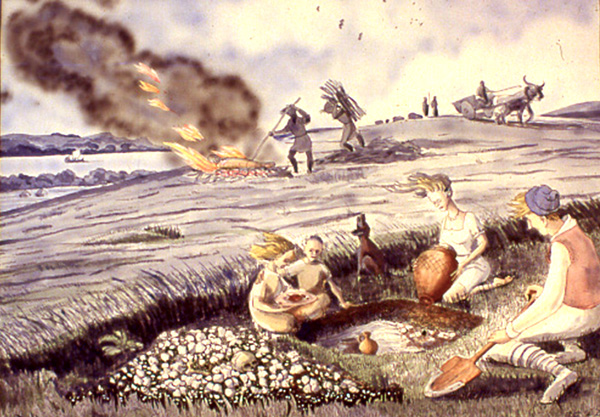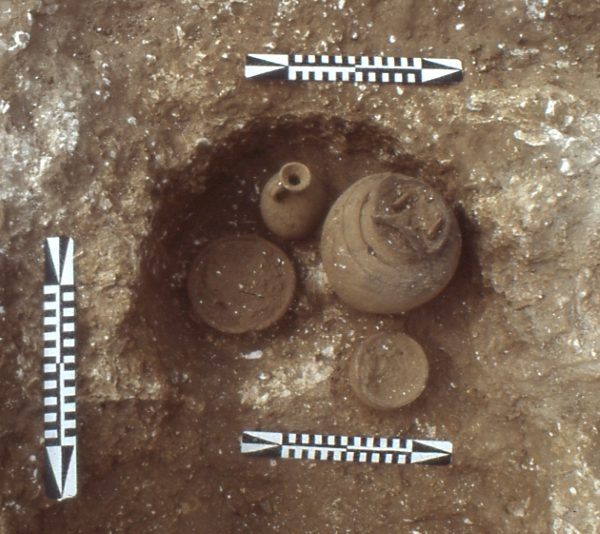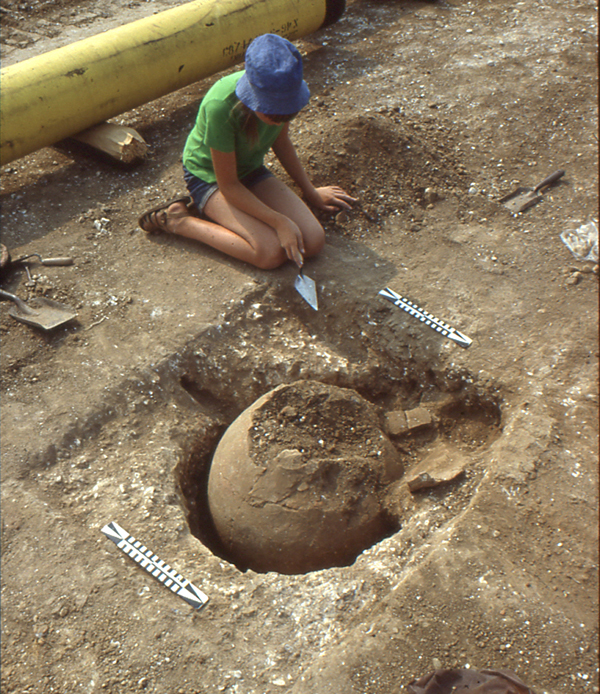
The image for Day 240 of the VM_365 project is of an artists reconstruction of the child’s grave, containing cremated remains and accessory vessels, based on one (Grave 5) excavated on a gas pipeline near Thorne, near Minster in Thanet, which was shown on Day 239. The painting is by Len Jay whose work reconstructing images from the Anglo-Saxon archaeology of Thanet, which he helped to discover, have featured in previous VM_365 posts on Day 216 and Day 217.
The image shows the rectangular pit being prepared to receive the pot containing the cremation, with the accessory vessels already in place. The grave has been excavated with a wooden shovel, strengthened by an iron blade added to the tip. On the left of the pit there is a heap of chalk from the geology that has been exposed below a thin covering of soil. Human bones are present in the chalk, reflecting the many thousands of years that the landscape was used to create funerary monuments and the fact that successive generations often disturbed the remains of those that came before them, accidentally or deliberately.
On the left of the group of figures surrounding the grave, a child is about to add a plate of food to accompany the vessels. Organic remains like food are something which we can not now detect through archaeology except in the rarest of circumstances, but the vessels imply that such perishable things were placed with the remains. The girl is comforted by a boy to her right and a dog howls into the air.
The burial of the cremated remains takes place on the crest of the ridge which forms the backbone of Thanet’s chalk landscape, in the top right a sailing vessel is shown in the Wantsum channel which is overlooked by the ridge. In the top right small figures tend a flock of sheep on the crest of the ridge. The prevailing wind that swept the open downland ridge, blowing the hair of the group to the left is still notable in the present day.
A cremation burial is simply the gathered ashes of a burnt body, that was arranged with vessels and other objects according to prevailing beliefs and sealed below a covering of soil, forming a lasting memorial to the person buried. The burning of a body is taking place in the background of this image on the crest of the ridge, using the wind to accelerate the wood fuelled fire so it could reach the temperatures that were necessary to reduce the body to ashes.
The landscape in this picture is recognisable to anyone who knows Thanet well, although it has changed considerably in recent years. However the details of the scene may reflect accurate archaeological data, it is still evocative of a distant time and of the human stories behind the objects that we recover as archaeological artefacts.
 The image for Day 239 of the VM_365 project shows Grave 5 from the Thorne Roman cemetery. This cremation burial, dating to the first century AD, was excavated along the Monkton Gas Pipeline route between 1983-4.
The image for Day 239 of the VM_365 project shows Grave 5 from the Thorne Roman cemetery. This cremation burial, dating to the first century AD, was excavated along the Monkton Gas Pipeline route between 1983-4.